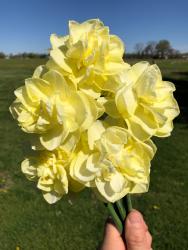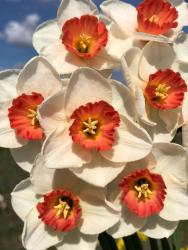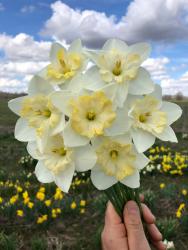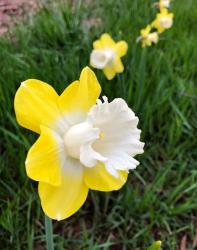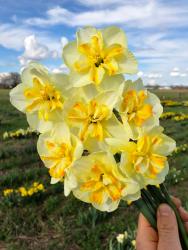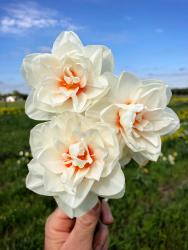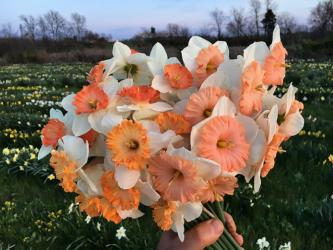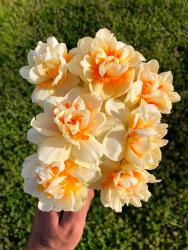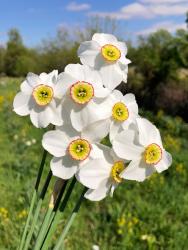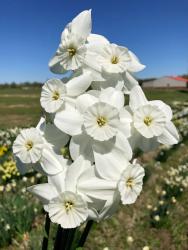Tell us a bit about yourself:
The first day of my nearly 21-year career at Missouri Botanical Garden began on January 2, 1996. Within a few months, I also took on the bulb gardens, my greatest passion. Over the course of my work in the Samuels and Heckman Bulb Gardens, the collection of daffodils went from fewer than 25 to nearly 700 because, why not?
After my 20th year at Missouri Botanical Garden, I decided it was time for a change of pace back out-of-doors, and took a position as horticulturist at Bellefontaine Cemetery and Arboretum. It was a fresh exposure from the collections aspect I had known at Missouri Botanical Garden, one I have since taken into my full-time endeavors with Professional Horticultural Services, my private company specializing in landscape design, maintenance, and daffodil breeding and commercial sales. The company officially began in 2003, and is now my full-time employment.
How did you get interested in daffodils?
Jason: My mother would have told you that it is because I was seven months in utero when she planted a row of daffodils along the fence line of our property in Illinois. As a child, I traveled with my dad to Louisville to a farm convention every spring. There were always forced daffodil and hyacinth bulbs on display. My grandfather started me on my first order of bulbs from a catalog when I was four or five. Later, I would save my lawn mowing money and flip through catalogs making lists of bulbs I wanted to buy. In college, I wrote to my first daffodil breeder with a list of bulbs I wanted to acquire.
Are daffodils your area of expertise or do you like with all bulbs?
Jason: Certainly, daffodils are where I have planted my business interests, as they are my favorite springtime bulb. I currently maintain a commercial collection of over 3,000 varieties, comprised of hybrids from around the world. But I also greatly enjoy and promote all bulbs—geophytes, technically speaking—and grow many different types in my home garden. I have hybridized varieties of Crinum (milk-and-wine lilies), Hemerocallis (daylilies), Hippeastrum (amaryllises), Lilium (true lilies), and of course, Narcissus (daffodils), with currently nearly a dozen daylilies introduced and as many daffodils in trials in the Netherlands for eventual commercial introduction. If our climate were conducive for year-round, outdoor culture I would also raise as many varieties of amaryllises as I could acquire — I love their flashy, gaudy flowers and ease of growth. Daffodils may be my favorite, but they are by no means the only bulbs worthy of my attention.
Why do you like daffodils?
Jason: When children are learning about bulbs, there is no easier thing for them to plant than a daffodil. Unlike tulips, daffodils come up year after year and, unlike tulips, they are resistant to deer and rabbits. As a child, my playground was my grandparents’ back yard. It was a magical wonderland. I grow a lot of daffodils from their collection. I still have visits from my grandparents by way of their daffodils.
What are your favorite daffodils and why?
Jason: It’s like saying you have three children, pick two. My favorites are the ones that persist in my garden no matter what. Out at the Shaw Nature Reserve, there are daffodils that have been coming up since the 1920s.
What are the best conditions for daffodils to flourish in?
Jason: They like full sun and well-drained soil with plenty of moisture in the spring and fall. They need to dry out during the summer. They need to be planted 6 to 8 inches deep no matter what. They have to be planted deep for them to come back year after year. They should be planted 8 to 10 inches apart. That one bulb will become two and then a beautiful clump over time.
What shrubs do you like to plant with daffodils?
Jason: I like shrubs that are not going to be too tall or too competitive: dwarf forsythia, dwarf weigela, fragrant sumac, bearberry, callicarpa (beautyberry) and hydrangea arborescens ‘Annabelle’ (the latter two bloom on new wood and can be cut back in late winter).
What landscaping challenge could daffodils correct?
Jason: Daffodils can make a beautiful display in an otherwise empty setting. They are easy and animal-resistant to deer and rabbits.
What are the best companion plants for daffodils as the foliage is going dormant (senescing)?
Jason: Look for perennials that do not need a lot of moisture during the growing season and have a good growth rate; anything that will be coming up as the daffodils are going down: baptisia, true geraniums, daylilies, peonies, asters, salvia, common milkweed. Avoid perennials with exceptionally dense, mat-like root systems unless you can regularly keep them in check. Shasta daisy "Becky," a gorgeous and otherwise perfect perennial, is one example of a mat-forming plant that may be a bit too aggressive.
What variety of daffodil is best to use in a floral arrangement?
Jason: They all have a good shelf life as a cut flower. It really depends upon the style of the arrangement. There are taller daffodils and some that would work in a nosegay. It depends upon what the designer wants. Cut them early in the morning, and the fresher the flower on the plant, the longer it will last.
To see more of Jason's work, check him out at phsdaffodils.com, [email protected] and www.instagram.com/phsdaffodils



